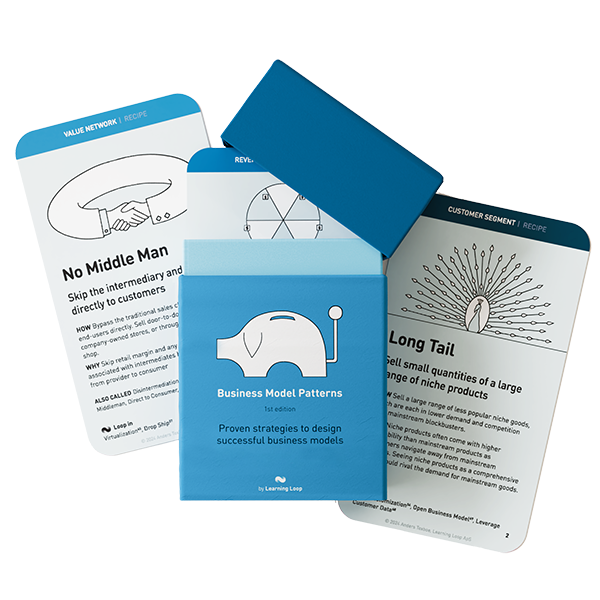Business Model Generation: Value proposition development
Open Source
Go Open Source to gain market mass and earn on affiliated products

How: Make your source code or product blueprint freely accessible for anyone under an Open Source licence. Let everyone contribute to the design and use it for free.
Why: Besides helping to open up a large user base, the collaborative production model of Open Source can help widen human capital invested and in turn help increase diversity of ideas and surface better solutions than if you were on your own.
Open Source
Open Source refers to a development model in which products (typically software) are created and maintained by a public community rather than by a single company. The source code is publicly accessible, enabling anyone with the appropriate skills to contribute to development and improvement. As a result, solutions developed through this process belong to the public at large, rather than any single organization. Open source products are also usually free for anyone to use, modify, and distribute, which raises an important question: how can a business build a profitable model around something that is given away for free?
Adopting an open source approach offers several advantages for companies. One key benefit is that it reduces the need for significant upfront R&D investment - the community contributes much of the work voluntarily out of passion or shared need. Companies can leverage the collective brainpower of external contributors to create solutions that might surpass what could be achieved in a closed, proprietary model. Open source projects also help set industry standards (driving wider adoption), and they free a company from dependencies on any single supplier or vendor, giving greater flexibility and control over the technology stack. Not least, being open can build goodwill and a user community more quickly since the low (or no) cost and transparency encourage adoption. It’s no surprise, then, that open source has become ubiquitous: some estimates indicate 96% of all commercial software programs include open source components A recent Harvard Business School study even estimated that firms would have to spend an additional $8.8 trillion to recreate the software that is currently available for free as open source - underscoring the massive economic value open source provides.
Where did the Open Source business model pattern originate from?
Open source development has its roots in the early software industry. Its earliest known use dates back to the 1950s at IBM, when a user group known as SHARE formed to exchange code and technical information among programmers and system users. This early form of community-driven software collaboration laid the foundation for the modern open source movement. (Notably, the term “open source” itself was coined much later - in 1998 - with the founding of the Open Source Initiative to promote software freedom in a way that appealed more to businesses.
The Emergence of Open Source in the Browser Market
In the late 1990s, open source development gained mainstream attention with Netscape’s decision to open-source the code of its web browser. Netscape’s move - motivated by competition with Microsoft’s Internet Explorer - led to the Mozilla project and eventually the popular Firefox browser. This experience demonstrated the potential of open collaboration to create competitive software products, and it helped pave the way for broader adoption of open source in the software industry. Around the same time, the formal Open Source Initiative was established (1998), marking a turning point where “open source” became a deliberate strategy in software development, distinct from the earlier Free Software movement.
The Growth of Open Source and the Emergence of Profitable Business Models
Over the years, Open Source Software (OSS) became an integral part of the software industry. One of the first companies to establish a profitable business model around open source was Red Hat, which built its revenue by selling support subscriptions and complementary software for the Linux operating system. Red Hat’s success proved the viability of open source as a business - the company grew to billions in revenue and was acquired by IBM in 2019 for $34 billion. This testimony of open source’s business potential inspired many others. By the 2000s and 2010s, numerous companies (from startups to tech giants) were generating significant revenue from open source products or platforms, either through services (e.g. IBM’s services around Linux), dual-licensing models (e.g. MySQL database), or the “open core” model (e.g. Elastic, MongoDB, etc. offering a basic open version and paid upgrades). Open source had evolved from a fringe concept into a mainstream business strategy.
Applying the Open Source business model
Open source development has wide application in software and even beyond. By embracing an open source model, an organization relinquishes a degree of control over a project’s development, but in return it can gain competitive advantages through community-driven innovation, faster adoption, and the establishment of a loyal user base. Open sourcing a product can help set a de facto standard in the market - if your open solution becomes widely adopted, ecosystem partners and customers are more likely to stick with your offerings. It also means sharing the costs and risks of development with the community. In essence, you are creating a pool of users (and potential contributors) to whom you can later sell additional commercial products or services once the open source project has built momentum and trust.
Despite open source software being available at no cost, companies have found many ways to generate income around an open source project. It’s well understood that open source itself doesn’t generate revenue directly. The code is free, so the business value comes from building services or complementary offerings on top of that open foundation. Rather than selling the software license, organizations can offer paid support, hosting, or extensions that provide value to users. This allows companies to derive revenue indirectly while still maintaining the free and open nature of the core product. (In other words, charging a license fee for the software is off-limits under open source licenses, but charging for complementary services or products is perfectly viable.)
The biggest challenge with an open source business model is not creating value (the software may create a lot of value for many), but capturing a share of that value. When designing an open source-based business model, it’s important to ensure that at least some of the value created by the project flows back to the originating company. This often means finding a smart balance between what you give away and what you monetize. For example, many companies keep certain advanced features proprietary (the “open core” approach) or focus on selling usage convenience (like cloud services), so that they benefit commercially even as the core product remains free. If you open everything without any such strategy, you risk others (including competitors or cloud providers) capturing the monetary value of your project. Successful open source businesses plan from the start how to retain a competitive edge - whether via exclusive features, expertise, branding, or other means - while honoring the open ethos that drives community adoption.
How do open source companies make money?
Companies have several strategies to monetize open source software without undermining its open nature. Common approaches include:
- Selling support and consulting services. Offer paid support, integration, or consulting to users of the open source software. Enterprise customers may pay for guaranteed assistance, customization, or SLAs. For example, Red Hat provides subscription-based enterprise support for its open source Linux distribution.
- Developing and selling additional features or products (“Open Core”). Release a basic version of the product as open source, but sell premium features, add-ons, or an enhanced “enterprise” edition under a commercial license. This freemium model (open core) lets users adopt the free core while converting a fraction of them to paying customers for the extra value. For instance, many database and developer tool companies offer a core OSS product and charge for advanced plugins or scalability features.
- Offering hosted or managed services (Software-as-a-Service). Provide a convenient cloud-hosted version of the open source software and charge for usage. Many customers will pay for the convenience of not having to install or manage infrastructure. This is a prevalent model today - the company runs the open source software as a service (often with added proprietary management features) and earns recurring revenue. For example, Elastic offers a cloud-hosted Elasticsearch service and other commercial features around its open source tools.
- Selling training, certification and education. Offer paid training courses, certification programs, or documentation enhancements for the open source software. Enterprises adopting the tool might invest in official training for their teams, which the originator company can provide for a fee. This not only generates revenue but also strengthens the ecosystem around the software.
- Dual licensing the software. Use a licensing strategy to serve both open source and commercial needs. In a dual-license model, the software is available under an open source license and under a separate proprietary/commercial license. The open source license allows community use and contributions, but a company that wants to embed the code into their closed-source product (or avoid the obligations of the open source license) can purchase a commercial license instead. MySQL database famously employed dual licensing: it was GPL-licensed for the community, but companies could buy a proprietary license for commercial use.
These opportunities for income generation can vary depending on the specific software, the user base, and the competitive landscape. Often, open source companies will combine multiple monetization methods (for example, offering a hosted service and selling premium features, plus maybe consulting). The overarching idea is to monetize the open source project’s popularity and user base without limiting its accessibility and freedom, which are the very qualities that drive adoption. In practice, this means charging for added value - extra services, convenience, or capabilities - rather than for the software itself. A company that strikes this balance well can build a sustainable business while also cultivating a thriving open source community around its product.
The future of Open Source
As open source becomes even more prevalent across industries, it is increasingly accepted as a viable (even essential) approach to technology development. Virtually every major software provider and cloud platform today engages with open source - either by using it, contributing to it, or open-sourcing their own projects. (Even companies that once opposed open source, like Microsoft, are now among the top open source contributors. This broad adoption means open source is now a fundamental part of the innovation ecosystem, driving cost-effective collaboration and faster iteration.
Looking ahead, the open source model is likely to continue evolving and expanding. More projects and organizations are adopting open development not just for software tools but also for data, artificial intelligence models, and hardware designs. We may see new hybrid business models that support open source sustainability - for example, “open core” hybrids, new licensing arrangements, or increased corporate sponsorship of open projects, which all aims at balancing community growth with the need to fund development. The tension between openness and monetization will persist as a key challenge: companies must continuously ensure they capture enough value to thrive without alienating the developer communities that make open source possible. Nonetheless, the benefits of open source, from lower costs and faster innovation to community-driven problem solving and flexibility in adoption, mean that it will remain at the heart of the software business for the foreseeable future. In short, open source is not just a development model or a buzzword; it’s a strategic asset and a cornerstone of modern business models in tech.
Real life Open Source examples
Automatic & Wordpress
The free-to-install content management system software is also available as a paid subscription service on Wordpress.com.
Google & Android
Google Open Sourced its Android mobile operating system for free, earning revenue from its Play Store and mobile searches.
Wikipedia
The online encyclopedia, launched in 2001, has become the world’s most widely used reference work. Articles are written and edited by a global community of users and the platform is sustained through donations. Through its Open Source model, Wikipedia has disrupted the traditional encyclopedia market and forced established publishers to adapt their business models.
mondoBIOTECH
The Swiss company operates as the world’s first Open Source biotechnology firm. Its mission is to identify compounds for the treatment of rare diseases, known as ‘orphan diseases’. Instead of laboratory research, the company screens existing research results and information for potential compounds, which is a more efficient and cost-effective method. Just 11 years after launch, the company has developed a pipeline of over 300 active substances, 6 of which have achieved orphan drug status.
Local Motors
Launnched in 2008, it is the first Open Source car maker. It operates on an open design network, allowing engineers worldwide to contribute ideas and collaborate on car development on its online platform. Their first car, the Rally Fighter, was developed and produced using this model, and while only 150 units have been sold, Local Motors reached its break-even point barely two years after launch.
Trigger Questions
- Is our strategic direction in line with community goals?
- How can we capture value while still sharing our research and development efforts?
- Is the technology amenable to an Open Source approach?
- Would open collaboration on our research and development endeavors yield a strategic advantage?
- Does the Open Source business model promise the potential to generate and capitalize on value?
Proven business models that have driven success for global leaders across industries. Rethink how your business can create, deliver, and capture value.
Get your deck!Related plays
- Business Model Navigator by Karolin Frankenberger and Oliver Gassmann
- Business models for open-source software by Wikipedia
- 6 motivations for consuming or publishing Open Source software by Ben Balter
- 35 Top Open Source Companies by Cynthia Harvey
- Open Source Software: The $9 Trillion Resource Companies Take for Granted by Frank Nagle, Manuel Hoffmann, and Rachel Layne
- Duparc, E., Möller, F., Jussen, I., Stachon, M., Algac, S., & Otto, B. (2022). Archetypes of open-source business models. Electronic Markets, 32(3), 727–745.
- Hoffmann, M., Nagle, F., & Zhou, Y. (2024). The value of open source software (Working Paper No. 24-038). Harvard Business School.
- Open source strategy by Rašić, S.
- Shepardson, D. (2019, July 9). IBM closes $34 billion deal to buy Red Hat to boost cloud business. Reuters.
- Zilliz. (2023). How do companies monetize open-source software? Zilliz Blog.

